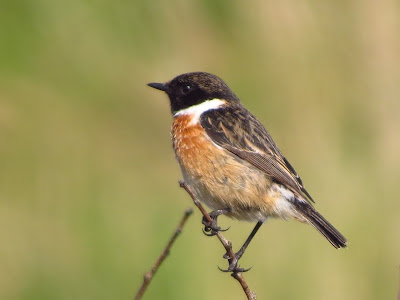Friday
22nd April fresh N Cloudy with occasional light
rain. Cool 8C with cold wind.
Καλημέρα
God morgon
Доброго ранку
Magandang umaga
Goeie more
Bom Dia
Buna dimineata
Maidin mhaith
in other words . . .
Good Morning!
It
is amazing to see on the blog where people who are following me come
from. It is possible to see the countries and in the last week the
above morning greeting represents the top ten countries. Thanks to
you all and I hope that my pages may inspire you all to try Green
Birding and do your bit to limit Climate Change/Global Warming. On that subject, it is so wonderful to see the commitment Leonardo di Caprio has to this as his latest donations show.
http://www.telesurtv.net/english/news/Leonardo-DiCaprio-Donates-3.4-Million-to-Ecuador-20160122-0006.html
The
Oracle's text from the previous evening states that there are two
black terns at Alton Water south of Ipswich; a bird that I have never
managed to see whilst cycling so of major importance to add to the
list. After fixing th back brake in the shelter of the South hide and
after a chat with an early rising RSPB staff member, I set off south.
Leaving Minsmere is strange after the last four days here. Each day
has been different and I feel I know the reserve a lot better having
explored every pathway. This could easily become my favourite RSPB
reserve, so diverse and with such incredible biodiversity.
By
9:00am I am at Blaxhall youth hostel and having no word from Phil
about the terns, I book in. Coffee and washing up, my phone receives
two texts and I miss a phone call. The terns are still there! With
apologies to Amy, the hostel manager, and reimbursed the overnight
cost, I set off once more as the weather deteriorates and spitting
rain falls.
Through
Woodbridge and Ipswich, where I make the mistake of following the
convoluted Route 1 Sustrans cycle path instead of the straight main
road, I get, eventually, to Lemon's Hill bridge. A gentleman in a car
calls my name. Chris Baines, a facebook friend who I had last seen
whilst watching a bluethroat near The Hook on Blakeney Point four
years ago, Calls me over and together we watch distant terns. A year
tick, seven or more arctic terns are over the water and then I
actually make a little leap into the air.
A black tern comes into
view. Brilliant. It is cold and raining slightly so photographs are
appalling but both birds are on the list, 219. Black tern becomes the
latest '16' bird, one that I didn't see last year. I need sixteen of
these over and above the 289 I did see. Now maybe it is the cricket
fan in me but I break the 16 down into 4 per quarter, that is four
'16' birds per three month period. January to March gave me four :
dusky warbler, Hudsonian whimbrel, glaucous gull and greater
yellowlegs. April has given me two already, savi's warbler and now
black tern. Things are looking good. Little targets to keep the
spirits up and keep the legs pedalling.
Another
pleasing thing from the bridge is the number of hirundines hunting
flies low over the water. They are mostly swallows with some sand
martins and the occasional house martin.
Saying
goodbye to Chris, as I am now starting to shiver, I head off along
the circumnavigating the lake cycle path. A helicopter comes low and
lands in a garden backing onto the path.
Three
miles later I am warming up with a large hot chocolate and enjoying
the company of Gina and Andrew, the owners of the cafe at the south
end of the lake. Mentioning the helicopter I am told it belongs to a
city banker.
The
only other customer in the cafe is Doreen, a local originally from
Anfield, Liverpool. The four of us chat awhile before all too soon it
is closing time and I carry on to search the lake for other birds.
Three little gulls were reported this morning but they have moved on.
The
Green Year list now stands at 219, still 30 birds ahead of this time
last year.
50.69
miles 1473 feet elevation up 1443 elevation down




























